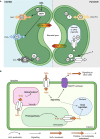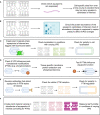Exploring aquaporin functions during changes in leaf water potential
- PMID: 37615024
- PMCID: PMC10442719
- DOI: 10.3389/fpls.2023.1213454
Exploring aquaporin functions during changes in leaf water potential
Abstract
Maintenance of optimal leaf tissue humidity is important for plant productivity and food security. Leaf humidity is influenced by soil and atmospheric water availability, by transpiration and by the coordination of water flux across cell membranes throughout the plant. Flux of water and solutes across plant cell membranes is influenced by the function of aquaporin proteins. Plants have numerous aquaporin proteins required for a multitude of physiological roles in various plant tissues and the membrane flux contribution of each aquaporin can be regulated by changes in protein abundance, gating, localisation, post-translational modifications, protein:protein interactions and aquaporin stoichiometry. Resolving which aquaporins are candidates for influencing leaf humidity and determining how their regulation impacts changes in leaf cell solute flux and leaf cavity humidity is challenging. This challenge involves resolving the dynamics of the cell membrane aquaporin abundance, aquaporin sub-cellular localisation and location-specific post-translational regulation of aquaporins in membranes of leaf cells during plant responses to changes in water availability and determining the influence of cell signalling on aquaporin permeability to a range of relevant solutes, as well as determining aquaporin influence on cell signalling. Here we review recent developments, current challenges and suggest open opportunities for assessing the role of aquaporins in leaf substomatal cavity humidity regulation.
Keywords: hydration; hydraulic; membrane transport; solute flux; water channel.
Copyright © 2023 Byrt, Zhang, Magrath, Chan, De Rosa and McGaughey.
Conflict of interest statement
The authors declare that the research was conducted in the absence of any commercial or financial relationships that could be construed as a potential conflict of interest.
Figures





Similar articles
-
Regulation of plant aquaporin activity.Biol Cell. 2005 Oct;97(10):749-64. doi: 10.1042/BC20040133. Biol Cell. 2005. PMID: 16171457 Review.
-
Versatile roles of aquaporin in physiological processes and stress tolerance in plants.Plant Physiol Biochem. 2020 Apr;149:178-189. doi: 10.1016/j.plaphy.2020.02.009. Epub 2020 Feb 12. Plant Physiol Biochem. 2020. PMID: 32078896 Review.
-
Insights into structural mechanisms of gating induced regulation of aquaporins.Prog Biophys Mol Biol. 2014 Apr;114(2):69-79. doi: 10.1016/j.pbiomolbio.2014.01.002. Epub 2014 Feb 1. Prog Biophys Mol Biol. 2014. PMID: 24495464 Review.
-
Regulation of leaf hydraulics: from molecular to whole plant levels.Front Plant Sci. 2013 Jul 15;4:255. doi: 10.3389/fpls.2013.00255. eCollection 2013. Front Plant Sci. 2013. PMID: 23874349 Free PMC article.
-
Drought, abscisic acid and transpiration rate effects on the regulation of PIP aquaporin gene expression and abundance in Phaseolus vulgaris plants.Ann Bot. 2006 Dec;98(6):1301-10. doi: 10.1093/aob/mcl219. Epub 2006 Oct 7. Ann Bot. 2006. PMID: 17028296 Free PMC article.
Cited by
-
Antioxidant activity and comparative RNA-seq analysis support mitigating effects of an algae-based biostimulant on drought stress in tomato plants.Physiol Plant. 2024 Nov-Dec;176(6):e70007. doi: 10.1111/ppl.70007. Physiol Plant. 2024. PMID: 39703136 Free PMC article.
-
ABA-GA antagonism and modular gene networks cooperatively drive acquisition of desiccation tolerance in perilla seeds.Front Plant Sci. 2025 Jul 23;16:1624742. doi: 10.3389/fpls.2025.1624742. eCollection 2025. Front Plant Sci. 2025. PMID: 40772050 Free PMC article.
-
Post-translational modification acts as a digital like switch influencing AtPIP2;1 water and cation permeability.Sci Rep. 2025 Jul 2;15(1):22552. doi: 10.1038/s41598-025-06200-9. Sci Rep. 2025. PMID: 40594625 Free PMC article.
-
Physiologic, Genetic and Epigenetic Determinants of Water Deficit Tolerance in Fruit Trees.Plants (Basel). 2025 Jun 10;14(12):1769. doi: 10.3390/plants14121769. Plants (Basel). 2025. PMID: 40573757 Free PMC article. Review.
References
-
- Andersen T. G., Liang D., Halkier B. A., White R. (2014). Grafting arabidopsis. Bio-protocol 4, e1164. doi: 10.21769/BioProtoc.1164 - DOI
-
- Ariani A., Barozzi F., Sebastiani L., di Toppi L. S., di Sansebastiano G. P., Andreucci A. (2019). AQUA1 is a mercury sensitive poplar aquaporin regulated at transcriptional and post-translational levels by zn stress. Plant Physiol. Biochem. 135, 588–600. doi: 10.1016/j.plaphy.2018.10.038 - DOI - PubMed
Publication types
LinkOut - more resources
Full Text Sources

